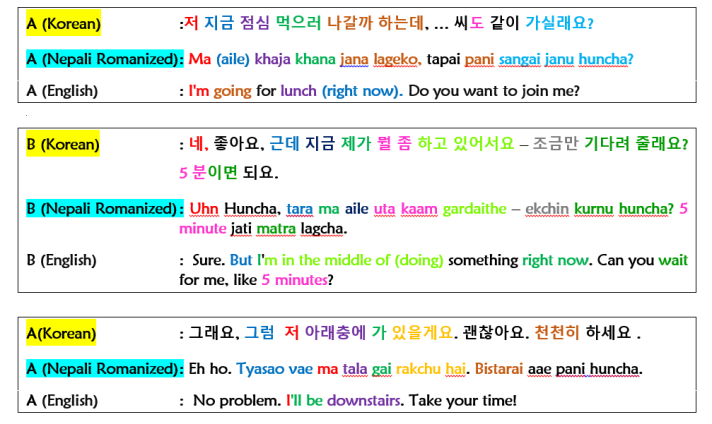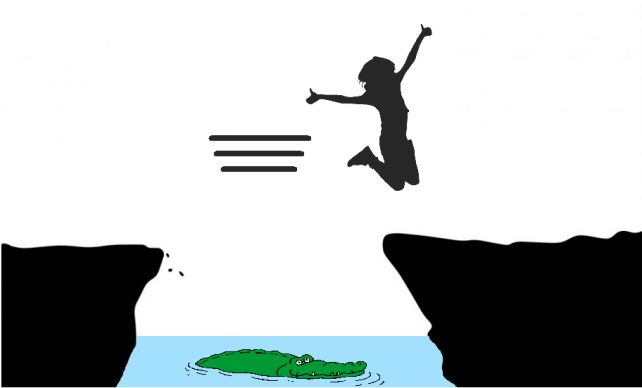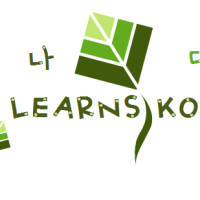Since my early teenage years, I had always wondered whether one’s nationality or gender has any effect on one’s capability to learn a language better.
I stumbled on this thought when I attended some lecture at school by a foreign teacher. I don’t exactly remember what the lecture was all about, but I remember the teacher telling us that we were quite lucky because, as per her, we have a neutral accent. So, basically, she was saying that we (the Nepalese) were lucky in terms of language learning, because we have a neutral accent. After that incident, the more I thought about it, the more it seemed true. And once I started learning Korean, I was reminded of this fact every single time.
As a Nepali growing up in one of the most culturally rich South Asian nations, Nepal, we essentially learn or know at least four languages: Nepali (네팔어,the national language), English (영어, the official teaching language at most schools, at least in all cites), one’s caste specific language (Newari 네왈어, in my case; Every caste has their own unique language), and Hindi (인도,that we learn from massive exposure to Indian television). And if you have a close friend that belongs to some other caste or if you live in a community with majority of people from some other caste, you are most likely to learn a fifth or even a sixth language.
So I know four languages just because I am a Nepali. I am fluent in Nepali and English. And I fully understand Newari and Hindi (but my speaking skills aren’t that good). And I am learning Korean. So, that makes it five. Therefore, my brain is already wired to handle multiple languages. Out of the four languages that I know, three (Nepali, Hindi and Newari) are quite similar in terms of structure, syntax and vocabulary (to some extent) although there are some stark differences as well; whereas English has a completely different structure on its own.
As for Korean, when I first started learning Korean, I picked up the basics such as the sentence structure, verb conjugation, etc., quite easily. I used to watch a lot of videos on YouTube (TTMIK, Koreanclass101, Conversational Korean, sweetandtastyTV and many more), and learn the verbs, basic nouns, pronouns, etc. I also used to look up a lot of videos and blog posts about how other foreigners were learning Korean, things like “tips for learning Korean or learning a second language, in general”. And I began noticing that many people, mostly non-Asian English speaking Korean learners, struggled quite a lot, mostly at the beginning with the Korean sentence structure. But I couldn’t understand why that was the case, because for me, the sentence structure in Korean S-O-V “난 학교에 간다” which is “I to school go” in English was a very simple concept. You just push the verb to the end of the sentence. Moreover, although my native language is Nepali, I was learning Korean in English as well, the same way these English speakers were doing. So, I wondered why the whole “verb-at-the-end-of-the-sentence” thing was not a problem for me at all. But, I felt quite stupid afterwards, when I realized that the whole S-O-V structure is exactly what Nepali AND Newari AND Hindi follows too. (It surprisingly took me quite a long time to realize that, as I was translating everything in English while learning Korean!) Therefore, although I was learning Korean in English, my brain was already used to shoving the verb to the end of the sentence. So the Korean structuring was nothing new for my brain at all.
This made me realize that just because I was a Nepali (still am btw), I could easily skip the whole process of wrapping my head around many concepts, the sentence structure being just one case. Well, I am not talking about just a simple “I go to school” structure, much longer sentences in Korean have an almost identical translation in Nepali. That is why, all I needed to do was learn the words, build my vocabulary and I was all good to go. For example, a sentence like “I got tons of compliments for my looks at yesterday’s party” which is something like “Ma hijo office ko party ma gako ta sable malai kasto ramri dekheko vane”, is almost identical in Korean: 어제 (난) 회사 파티에 갔더니, 다들 정말 예쁘다고 말했다/칭찬했다. To illustrate what I am saying, let’s see a whole dialogue.
Notice the word order in the structure. Same or almost same words have been colour coded using the same colour in all three languages (Korean, Nepali and English):

(I got this dialogue (the Korean part) from one of the episodes from a great YouTube Channel called “라이브 아카데미” literally, “Live Academy” in English, which is an awesome channel for learning real life Korean language. Live Academy is a great channel run by a Korean instructor 신용하, originally to teach English to Korean speakers. But it works amazing the other way around too. I’m using this channel for learning Korean dialogues and for practising speaking. The channel uploads at least 3 videos per week and talks in detail about very useful real life dialogues and phrases. However, the channel is appropriate for Korean learners from lower immediate level to above, as the whole video is in Korean (except for the sample sentences in English and Korean, which he explains AMAZINGLY).

Anyway, that was quite a digress there! Coming back to the point. As you can see from the colour coding in the dialogue. The sentence structure and word order in Korean and Nepali is almost a perfect match. Except for some minor changes in some nuances, everything overlaps perfectly. So, you basically just need to know the Korean counterpart of every Nepali word to be able to form the majority of the sentences in Korean.
On the other hand, have a look at the English sentences. The sentence structure is a complete mess (엉망진창이다!) compared to both Nepali and English (Good thing we learnt English from an early age at school!) Therefore, just because of the fact that I am a Nepali, I have this what I call “Language Privilege” or benefit over other Korean learners (from other countries) “of not having to learn certain concepts THE HARD WAY!” My brain can simply skip them, jump over to newer things.

Pronunciation Privilege
In addition to having a great “privilege” of not having to learn certain concepts in Korean, your nationality and native language also gives you certain benefits in terms of pronunciation. In my case, Nepali happens to be one of the richest languages in terms of sounds (Yeah! I realized this too while learning Korean). It has almost every sound in the world (except for any clicks such as in African languages).
Anyway, with 36 consonants, 12 vowels and many diphthongs, we, the Nepalese, have all the sounds necessary to pronounce any Korean word, fully registered in our brains. It may sound as boasting, but it is genuinely the case. For example, I have seen other Korean learners struggle with the “ㄱ” category of sounds in Korean. Korean essentially has three consonants in this sound category “ㄱ”,”ㅋ” & “ㄲ”. And these three consonants are fairly easily distinguishable for most learners, when they are being used in the same word. For example, Korean learners, irrespective of their nationalities, would have no problem pronouncing the word “크기” (khugee) meaning “size” once they are familiar with “ㄱ” and “ㅋ”.
But the problem begins when the same “ㄱ” sound is used multiple times in the same word as in “가게”, “고기”, 공기”, “기계”,etc., where the “ㄱ” is pronounced differently in each instance. At first encounter, every learner would face the same problem “How to pronounce the two ‘ㄱ’s?”. But the language privilege that I am talking about, comes into play when the learner is told the correct pronunciation of the word. For example, the pronunciation of the word “가게” is Khaagay. When I hear the pronunciation of this word, I can easily tell the two “ㄱ” s apart because we have two completely different consonants in Nepali for the two “ㄱ” s. So, “가게” is खागे for us. The first “ㄱ” in the consonant is “ख” for us and the second “ㄱ” is “ग” for us. Likewise, “고기” is “खोगी”, 공기” is “खोङगी”, “기계” is “खीग्ये”, So, while even Korean uses the same single “ㄱ” to represent two completely different sounds, we have two distinct consonants for the two sounds. That’s why, after hearing the right way to pronounce such words, we never get confused regarding which “ㄱ” is pronounced which way. Not only this, Nepali in fact has four to five sounds/consonants for each of the key confusing sounds categories in Korean (one extra sound than Korean). It has sounds that does not exist in English as well. (If you want to see how Nepali script looks like, have a look at my earlier post here).

[Note: the Korean and Nepali consonants in a single column does not represent the same sound. I’m just showing the consonants in their general order in respective languages].
Consequently, it is much easier for us to distinguish similar categories of sounds than perhaps other English speaking Korean learners who have more limited sounds in their language. So, I guess, when my teacher then told us that we have a neutral accent, she meant this very thing of us having a very rich sound repository. Because of this, I believe Nepalese or even Indians (who have the same language script as Nepali) struggle less with grasping Korean sounds and thus are faster and better at Korean pronunciation. Of course I am not talking about language geniuses or language privileges that you have when you’re learning languages having same or similar origins. But it takes us less time and effort to master pronunciation than perhaps other learners from other countries (mostly from English speaking nations).
And this amazes me every time as Korean and Nepali are completely unrelated to each other and have no similar origins whatsoever (not at least to my knowledge). Korean, as we know, have a lot of influence from Chinese and Nepali has its origins rooted in Sanskrit, Pahari and some Tibetan languages. Therefore, I have not encountered a single cognate or loan word or even false cognate between Korean and Nepali to this day. But the similarities in sentence structure and some cultural aspects is simply astonishing.
So, do you have a similar or a completely different “language privilege” by the virtue of your own native language that you’ve discovered while learning Korean or any other second language? If yes, do share!
진짜 오랜만에 CHEERS TO ALL LANGUAGE LEARNERS! 화이팅!
Watch Full Lesson Video from LIVE ACADEMY – 라이브 아카데미 that I got the dialogue from:
Featured Image for this post was brought from: 1, 2 & 3


Hi! This post is really thought-provoking!
It’s amazing how the structure of Korean and Nepali languages overlap!
As a French native speaker, I’m indeed struggling with Korean sentence structure. Not in the beginning though. Probably because the French language sometimes uses an SOV structure. When we don’t want to be redundant while talking about something, we do use a specific pattern in which we substitute the subject with a predicate that we place before the verb. So simple sentences are not a big deal. However, compound-complex sentences is another story! You pointed it out well, the structure is a complete mess. Thus, I need a lot of exposure to soak it up.
Still, regardless of the structure (that gave me headaches from time to time), the most difficult part is simply the way Korean speakers phrase their thoughts. For example, it is natural in Korean to say ‘책을 읽어 봐요’. To me, associating 읽다 and 보다 don’t come naturally at all. I would never think of expressing it that way. In the end, it’s not only about the order of words but the combination of words as well that can be difficult.
Alright. Have a nice day 🙂
LikeLiked by 1 person
Thank you so much for the comment!
Wow! I didn’t know that French uses SOV structure as well.
I remember one of our customers (who I think was a French language teacher) telling us that if you learn French your English kind of gets messed up as well sometimes.
Anyway, I really found your comment about how your expressions of thoughts are different than Korean quite intriguing. So I think just like 보다, perhaps you find the verb 주다 as in to do sth for sb 뭔가 히주다 different as well.
I think I can write a new post about this as well.
Thanks a lot! I didn’t realize this! Your comment, in fact, was thought provoking indeed!
LikeLiked by 1 person
Neither did I. French is primarily SVO, but thanks to Korean, I noticed we have that specific SOV structure that probably annoys some French learners indeed.
You’re right! 뭔가 해주다 was a bit disconcerting at first. The concept is actually logical “you do it for” so in a way it’s a giving. I get that. But It would not naturally come to my mind.
That’s why many learners and teachers always tell us to not refer to our native tongue structures and to “think in that language”.
See you!
LikeLiked by 1 person
True! You really do have to brainwash yourself into thinking in your target language! 😃😃😃
LikeLiked by 1 person
I love this article! I know next to nothing about Nepali, so this taught me quite a few interesting facts about your language. It also got me thinking about what ‘language privileges’ I might have when it comes to language learning…
This is something I did not realise until very recently, but I rarely ever struggle with spelling homophones in Korean, like 왜, 웨, or 받침 that take on similar sounds despite being entirely different consonants (ㅅ,ㄷ,ㄸ for example all take on the same sound as ending consonants). The reason for that is because I usually try to recall how words look and not how they sound when i’m writing them, and I think this may be due to the fact that my native language is Mandarin Chinese, and our writing system is composed of ideograms. Most of the time there’s no telling how a Chinese word is pronounced just by looking at it – you have to memorise how it looks and how it sounds separately. I think I may have inadvertently applied this learning method to Korean, even though it’s a phonetic language, but all the same, I have a feeling that my brain makes a clear distinction between how a word looks and how it sounds, and stores the information in two separate but neverthelessly linked compartments.
I also find replicating tones in other languages relatively easy. I’ve attempted learning phrases in a couple of Korean dialects (just for fun), and most of my friends were surprised by how natural my intonation sounded especially considering it was my first try. Korean dialects, as you’re probably aware, are very particular when it comes to tones (you have to remember precisely where to go up and where to go down, how far up or down do you have to go, etc), which is not unlike Mandarin Chinese and other Chinese dialects that I’ve had to learn, all of which are tonal languages. ‘Ma’ for example, can mean a variety of things depending on the tone you say it in, so messing up the tones can actually result in misunderstanding. Perhaps learning tonal languages early in my life has given me some sort of advantage when it comes to replicating tone.
LikeLiked by 1 person
Learning tonal language sure seems to have a lot of advantages. And I really find the whole idea of disassociating the look of a word vs how it’s read fascinating as well. I had a chance of taking a couple of mandarin classes once and I found the representation of a whole word through a beautiful symbol very interesting. Although I couldn’t wrap my head around the 4 tone differences then. But I plan to learn mandarin some day. So I’ll get there! 자신 있습니다.
Wow dialects 까지요!
That’s so amazing!
That must be quite fun!
I haven’t really tried learning dialects yet, but I’m quite familiar with them! It’s so fascinating how languages evolve across geographical distances. Both Korea (a small country) and China (a big country) have such variations in terms of dialects. But weirdly, we don’t really have such prominent 사투리 s in Nepal. Instead we have completely different caste based languages (different as in 완전 different such as Japanese vs Korean). You could ride a public bus and not understand a single word people (from another caste) are saying in their language, which is quite handy at times (you have your own secret language 😁).
But what you’re saying is quite true. Our own languages have given us the advantage of more easily accepting the eccentricities of other languages that other people may find difficult or time consuming to grasp.
Anyways, thank you for stopping by my bog!
LikeLiked by 1 person
0 Pingbacks
Social
Recent Posts
Recent Comments
My Calendar
Categories
Archives
Stupendo fantabulosly phantasmagorically magical Blogs I follow
I’m also on Twitter!
My TweetsTags
culture HelloTalk Korean language learning Learn Korean Learn Korean Language Talk to me in Korean TTMIKMeta
I write, then talk about it.
Unlock Real Spanish for Travel & Conversation
Best of Asia Food, Travel, Beauty and Dramas~!
A photographer's view of the world - words and images to inspire your travels and your dreams
Bringing magic to everyday life
Self-studying Korean from bed
From France to Korea -> Doctoral degree in Seoul
Tips, tools and resources to help your students rise in proficiency and communicate with confidence.
An Australian girl learning languages from home.